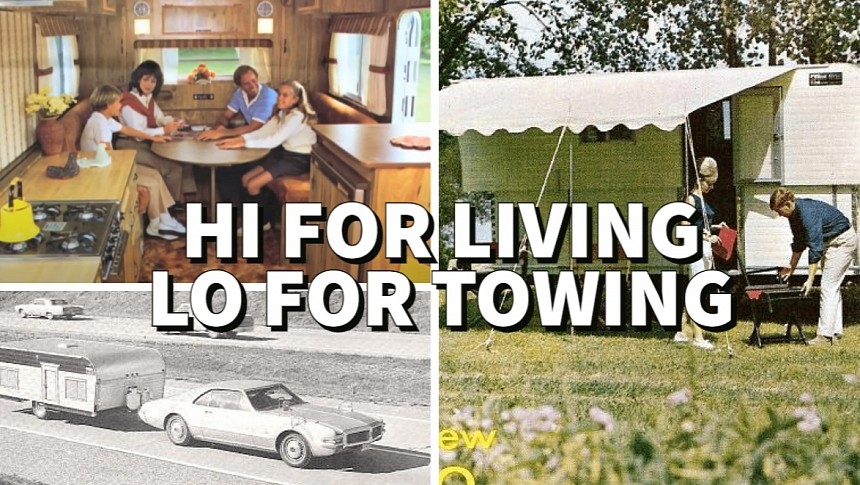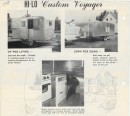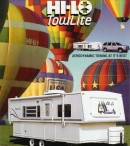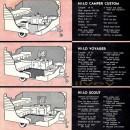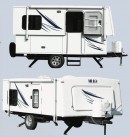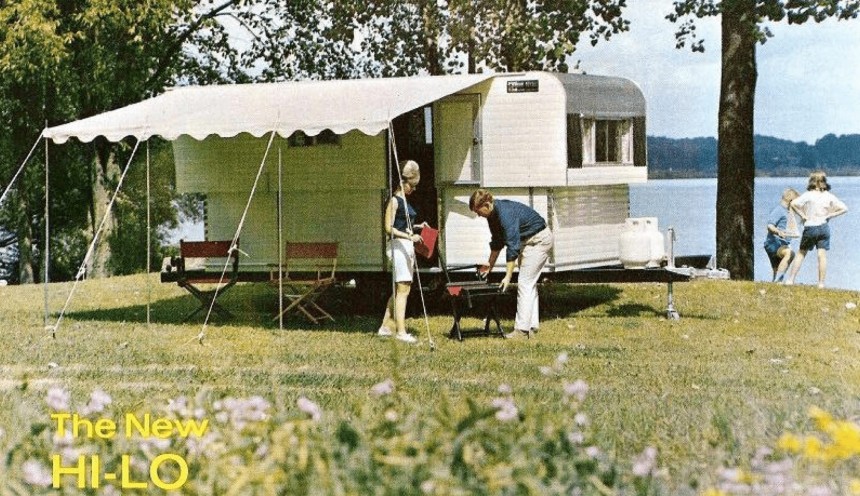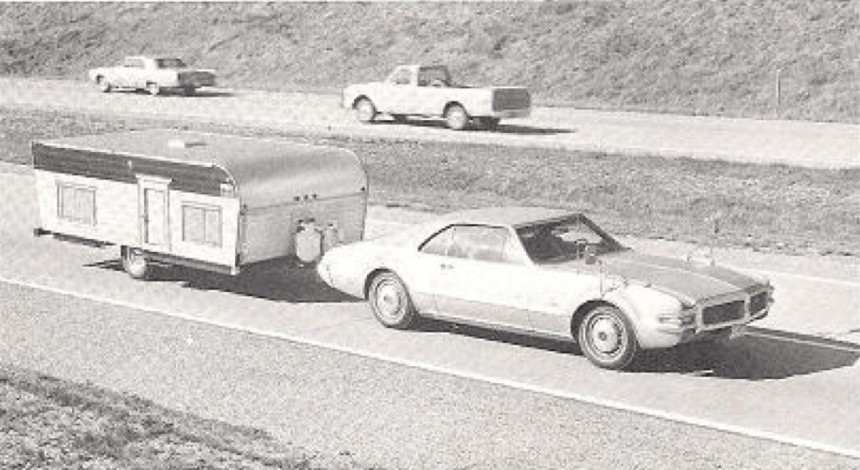You don't learn in school what you learn from personal experience, especially if said experience is negative. The Hi-Lo expandable trailer, an icon on the RV scene in the U.S., is a brilliant example of that, having been born out of the necessity for more comfort and safety at camp.
The Hi-Lo Travel Trailer goes all the way back to 1955 when Jim Snyder went camping with the family and spent a few nights in fear of raccoons or even bears coming into the tent. He wanted a better option for a family vacation, but one that wouldn't necessarily put a strain on their daily driver to increase mileage and costs.
In starting the design for such an upgrade, Snyder anticipated a gap in the market, one we'd now position at the conjunction of hard-wall trailers and pop-up towables, combing certain advantages from both into a single package. A very affordable package at it.
In 1957, Snyder had a product ready: Snyder's Hi-Lo, named this way because it featured a unique lifting mechanism that allowed it to double in size at camp. The design was actually inspired by a shoe box, where the upper part smoothly slides over the bottom one to close. Snyder's Hi-Lo had a crank to activate the lifting mechanism, so you could tow it in "closed” mode and then open it up to full height at camp.
The benefits were multiple, and they eventually translated into a very long life for the trailer: the low profile in travel mode meant less drag, which meant lower consumption and a safer, more stable drive. The higher height at camp allowed for a home-like RV for the entire family, packing a wide range of options and features, from sleeping for as many as six people to a full kitchen, at least one lounge area, and later on, when the lifting mechanism became automated, a full-size bathroom.
The first model, Snyder's Hi-Lo Voyager, was introduced in 1957. It was a 15-foot (4.5-meter) trailer that could accommodate a family of six in comfort with the additional bunks, sitting a little more than 5 feet (1.5 meters) from the ground and offering over 6 feet (1.8 meters) of headroom when deployed in camp mode. It's still referred to as the world's first expandable trailer to deploy this mechanism, though the claim was never duly verified.
That aside, it was an impressive RV, and not just because of the lifting mechanism. Promising to turn "every weekend into a vacation," it was "roomier than you think at a price you can afford," and it proved so popular that length variations were introduced very soon. In a couple of years, "Snyder” was dropped from the name, and the "Hi-Lo” name would live on for decades. Technically, it's still alive today, though it's no longer in production.
In 1959, producers on the popular show The Price Is Right saw it and were so impressed that they decided to introduce one such trailer as a prize package on every edition. As the years went by, the trailer changed and evolved, growing in size and capabilities to suit a variety of budgets and needs. The biggest upgrades were the introduction of an automated lifting mechanism, the addition of an expandable lounge (which you also made roll and pop-up out at the touch of a button), and the bathroom that was absent altogether in the first models.
The TowLite model, introduced in 2001 in several variations, is perhaps one of the most impressive and popular. With a welded tubular frame and a multi-layered body built with cues from aircraft design (interior paneling, EPS insulation, plywood, and fiberglass exterior skin), it boasted a 77% saving on the gas bill thanks to the low center of gravity and aerodynamic efficiency, as certified by the Transportation Research Institute in a comparison to a similar-length Fleetwood trailer, both traveling at a steady 65 mph (105 kph). It also boasted of no sway and improved stability even at highway speeds and packed a complete exterior kitchen that made it even "more perfect" for families, if such a thing is even possible – grammatically, it's not, but you get the idea.
By 2010, faced with serious economic challenges, Hi-Lo closed up shop for good. In 2014, Kerola stepped in and acquired the Hi-Lo trademark, designs, and intellectual property and, for a good few years, continued the Hi-Lo tradition while bringing new models to market. The goal was from the start to honor the legacy of the iconic travel trailer by offering maintenance and repairs on the older models while introducing new ones, like the flagship Wanderer '18. The mission was a success, for some time, until the 2020 international health crisis, when the business was forced to shut down once more.
In 2021, the Hi-Lo was still out of operation, with an update on the official website saying they were looking for a new manufacturing partner that would allow them to bring the Hi-Lo Travel Trailer back on the market. If this Phoenix was able to rise from the ashes once, here's to hoping it'll do it again because there's a very loyal following waiting for it.
In starting the design for such an upgrade, Snyder anticipated a gap in the market, one we'd now position at the conjunction of hard-wall trailers and pop-up towables, combing certain advantages from both into a single package. A very affordable package at it.
In 1957, Snyder had a product ready: Snyder's Hi-Lo, named this way because it featured a unique lifting mechanism that allowed it to double in size at camp. The design was actually inspired by a shoe box, where the upper part smoothly slides over the bottom one to close. Snyder's Hi-Lo had a crank to activate the lifting mechanism, so you could tow it in "closed” mode and then open it up to full height at camp.
The first model, Snyder's Hi-Lo Voyager, was introduced in 1957. It was a 15-foot (4.5-meter) trailer that could accommodate a family of six in comfort with the additional bunks, sitting a little more than 5 feet (1.5 meters) from the ground and offering over 6 feet (1.8 meters) of headroom when deployed in camp mode. It's still referred to as the world's first expandable trailer to deploy this mechanism, though the claim was never duly verified.
That aside, it was an impressive RV, and not just because of the lifting mechanism. Promising to turn "every weekend into a vacation," it was "roomier than you think at a price you can afford," and it proved so popular that length variations were introduced very soon. In a couple of years, "Snyder” was dropped from the name, and the "Hi-Lo” name would live on for decades. Technically, it's still alive today, though it's no longer in production.
The TowLite model, introduced in 2001 in several variations, is perhaps one of the most impressive and popular. With a welded tubular frame and a multi-layered body built with cues from aircraft design (interior paneling, EPS insulation, plywood, and fiberglass exterior skin), it boasted a 77% saving on the gas bill thanks to the low center of gravity and aerodynamic efficiency, as certified by the Transportation Research Institute in a comparison to a similar-length Fleetwood trailer, both traveling at a steady 65 mph (105 kph). It also boasted of no sway and improved stability even at highway speeds and packed a complete exterior kitchen that made it even "more perfect" for families, if such a thing is even possible – grammatically, it's not, but you get the idea.
By 2010, faced with serious economic challenges, Hi-Lo closed up shop for good. In 2014, Kerola stepped in and acquired the Hi-Lo trademark, designs, and intellectual property and, for a good few years, continued the Hi-Lo tradition while bringing new models to market. The goal was from the start to honor the legacy of the iconic travel trailer by offering maintenance and repairs on the older models while introducing new ones, like the flagship Wanderer '18. The mission was a success, for some time, until the 2020 international health crisis, when the business was forced to shut down once more.
